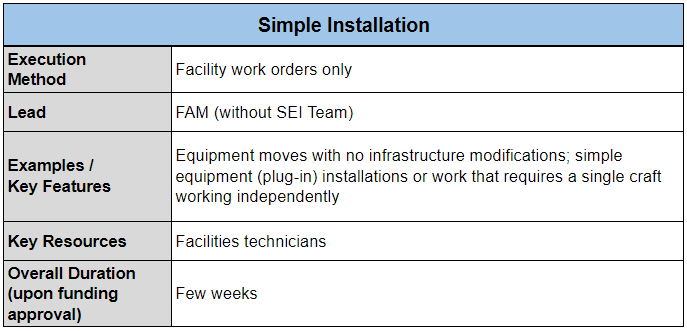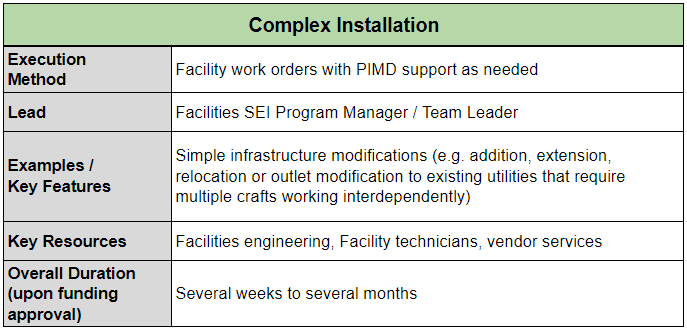The Scientific Equipment Installation (SEI) Team is a partnership between the Projects & Infrastructure Modernization Division (PIMD) and the Facilities Division to efficiently assess, plan, and execute scientific equipment installations and projects in support of the research divisions.
Why contact the SEI Team?
Some scientific equipment may come with complex infrastructure support requirements. And what may appear to be a simple equipment installation may actually be more complex than it first appears.
Key considerations in bringing in or moving equipment into a space include:
- Equipment Specifications (electrical power, temperature and humidity): The equipment may have utility requirements that cannot be met by existing infrastructure – especially if it requires additional power, new ventilation, or strict temperature and humidity ranges. In such cases significant modifications to the existing infrastructure may be required to prepare the space for the equipment.
- Building Code Compliance: Many legacy building systems may not comply with modern building codes. Any modification of existing spaces for the purpose of installing scientific equipment, even minor ones, may require updates to electrical panels, fire safety systems, and other systems to bring the space up to current safety standards.
- Electrical Safety: Any new equipment that is installed at Berkeley Lab must be certified by a Nationally Recognized Testing Laboratory (NRTL). Many foreign-made equipment may not comply which means the equipment must be certified on-site and be subject to specialized inspections to meet safety requirements prior to shipping and installation. These considerations may need to be accounted for in the purchase agreement.
- Waste Generation: Disturbance or demolition of existing infrastructure also may disturb legacy hazardous materials that must be abated or handled appropriately, which can complicate the overall installation.
Identifying these needs early (ideally before the equipment is ordered, or the funding is requested) will prevent delays in the installation.
The SEI Team can:
- help understand the feasibility of installing equipment in an existing space;
- propose potential spaces for the installations that minimize the need for infrastructure modifications;
- help identify necessary technical specifications for the equipment before ordering;
- provide an estimated cost and timeframe for the installation, including any pre-installation infrastructure work; and/or
- help tailor the scope of the infrastructure work to fit your budget
What can I expect?
Depending on equipment and the current state of the space, the work may be a simple installation, a complex installation, or become a full infrastructure project, as summarized in the table below. Your Facility Area Manager (FAM) can help determine whether your equipment needs may be a complex installation or a project that should be assessed and managed by the SEI team. Because these efforts can take months to more than a year, please contact the SEI team as early as possible.



The SEI team will begin by connecting with you to begin a review of your needs and to schedule a job walk, and pull the appropriate resources to meet your needs.
Contacts
Please contact the SEI Team at seiteam@lbl.gov
- Matthew Vieira – SEI Team Leader/Facilities Division
- Darren Finger – SEI Deputy Team Leader/Facilities Division
- Jenny Ledesma – SEI Project Director/PIMD
FAQs
What is considered scientific equipment?
Scientific equipment means equipment intended for the sole purpose of scientific research, teaching or experimentation, including programmatic instruments, apparatus and machines.
Can I get everything for my equipment installation taken care of by Facilities work orders?
It depends on the complexity of the work required. If the equipment installation is largely a like-for-like replacement, and/or just requires an extension to existing infrastructure that can support it, Facilities likely can handle the work in-house or with support of vendor services, and the installation will be coordinated by the Facilities SEI Team Leader. If any new power, heating, or cooling needs to be brought in; if other new process piping or utility conduits need to be built behind drywall; and/or if the installation is in an older building that requires significant updates to its systems to prepare for the installation, it likely will be outside the capabilities of the Facilities division and will require design services by a licensed architectural/engineering firm and a construction contractor managed by PIMD.
Why do infrastructure projects take so long/cost so much?
Construction is complicated and no two projects are exactly the same. Each project must be carefully scoped and planned, and must go through design, construction, and closeout phases in sequence so that the work proceeds as smoothly as possible. Established procedures are followed and deliverables are developed throughout each phase and during acquisition of design and construction services in accordance with Lab requirements and federal rules and regulations to ensure fairness, quality, and safety of the work being performed. Regular meetings are held throughout the planning, design, and construction phases to make project decisions and to keep stakeholders informed. All of this requires an appropriate level of engagement by a project management team supplied by PIMD, and from support functions supplied by Facilities, ES&H, and other organizations at the Lab.
In addition, the construction industry as a whole is still experiencing unprecedented shortages in materials, equipment, and labor that is causing longer lead times and higher prices than what may be expected. This makes it especially important to plan for the work as early as possible.
Can the institution pay for the infrastructure modifications needed to prepare the space for my equipment installation?
It is possible, but institutional funds are limited and the request for funds are weighed against multiple other priorities of the Lab. Please submit your request to the Infrastructure Office via your Area leadership as early as possible and the Infrastructure Office will evaluate your request against the Lab’s investment priorities.
Programmatic connections to existing utilities are always funded by the program.
What happens after I contact the SEI Team?
The SEI Team will work with you to assess your needs against the space, develop the scope of work, and identify the most efficient way to execute the work. This initial scoping effort will not be charged to your PID. If an estimate is needed to support a research proposal or funding request, however, a program PID may be needed for the estimating effort. Once you approve the approach developed, you will need to provide a PID for the remaining planning and the actual execution of the installation or project.

